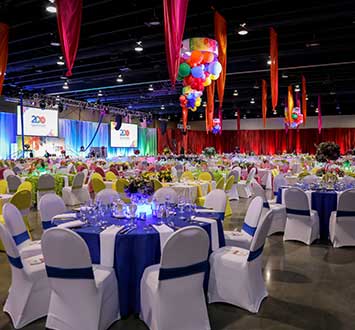

We ensure that all of our drapes meet all fire safety standards in compliance with federal regulations. Our pipe and drape products make your tradeshow booth stand out from the other exhibits without going over your budget. Georgia Expo banjo drapes are crafted from 100% polyester open-weave fabric at an attractive price. Pipe & Drape is affordable as well as fire-resistant

Each banjo drape is cut from approximately 48″ wide fabric bolts and has 4″ pockets sewn at the top and bottom for quick setup and enhanced durability.Īs a norm, standard 8 feet panels are sewn at 94” – which keeps the drape 2” off the floor.Īll drape sizes will be sewn to 2” off the floor unless otherwise specified.
GEORGIA EXPO FLOOR PROFESSIONAL
Pipe & Drape from Georgia Expo has earned the trust of exhibitors and organizers around the country for the finest banjo drapes they are available in brilliant colors, look gorgeous, and comply with fire marshal regulations.Ĭonvention Centers and professional exhibition designers frequently use banjo pipe and drape curtains for their decor. Phase I is intended to meet LEED standards and is targeted for completion by 2017.Description: Georgia Expo Pipe and Drape: Banjo Drape 34" X 48"
GEORGIA EXPO FLOOR SERIES
The second level fenestration is screened from the low eastern sun by a series of vertical linear cast-in-place elements that accommodate views across the campus from the meeting level. The ground floor includes extensive glazing to optimize views and a sense of continuity into the adjacent landscape.

The facades are envisioned as a sequence of repetitive gabled forms, made up of cast-in-place concrete and glass. Cores at the front and rear of the building provide mechanical and building support zones, with loading screened behind the building mass on the western edge of the campus. Support facilities are placed at the north end of the building on two levels. A second level includes 3 meeting pods of 5 modules each along with a VIP suite. Organized on two floors, the main level includes a grand lobby overlooking the gardens giving entry onto the column-free exhibition halls that can be subdivided into 5 sub-modules. The modules allow the new facility to carefully situate itself in relation to the existing historic structures on site, while also breaking down the scale of the 256-meter long facility. Phase I includes the first half of the convention center which was developed as a series of stepped bars or extrusions on a 9-meter module. An existing restaurant pavilion will be renovated nearby, joining a café set along the edge of an existing reflecting pool. The cineplex is placed at the southeast corner of the site, marking the re-envisioned south entry and a broad event lawn. These two linear facilities redefine the campus, offering a foil and frame for the landscaped gardens, courts and existing historic pavilions. The new convention center occupies the western edge of the campus while the hotel and ballroom complex is set along the north edge of the site. Outdoor decks and crushed granite courts accommodate outdoor exhibit and entertainment areas, enhanced by water features and a rich understory based upon regional precedents. Based upon an extensive network of pedestrian loops, the campus will eventually include two new entry courts off of the main boulevard, Tsereteli Avenue, which provide access to an interconnected sequence of outdoor rooms framed by planting and paving that define the public realm.

Trahan Architects collaborated with Christopher Counts Studio on the master plan for the landscape, developing a new design language and site order that connects the varied collection of spaces throughout the campus encouraging year-round use. The scale, texture, topography and available footprint of the existing site established the parameters of the two-phase master plan for the campus including a 52,000 sm exhibition center, a new 200-key hotel and ballroom, commercial development, a 10-screen Cineplex and below and above-grade parking. Soviet-era pavilions are distributed across the site, developed as a regional exposition during the 1960s. The complex is centered in an extensively landscaped sequence of gardens and park spaces, accessed by parkways and pedestrian paths. Expo Georgia, set within the post- industrial Didube-Chugureti district of Tbilisi, the capital of Georgia, is a 15-hectare campus located northeast of the historic city center.


 0 kommentar(er)
0 kommentar(er)
